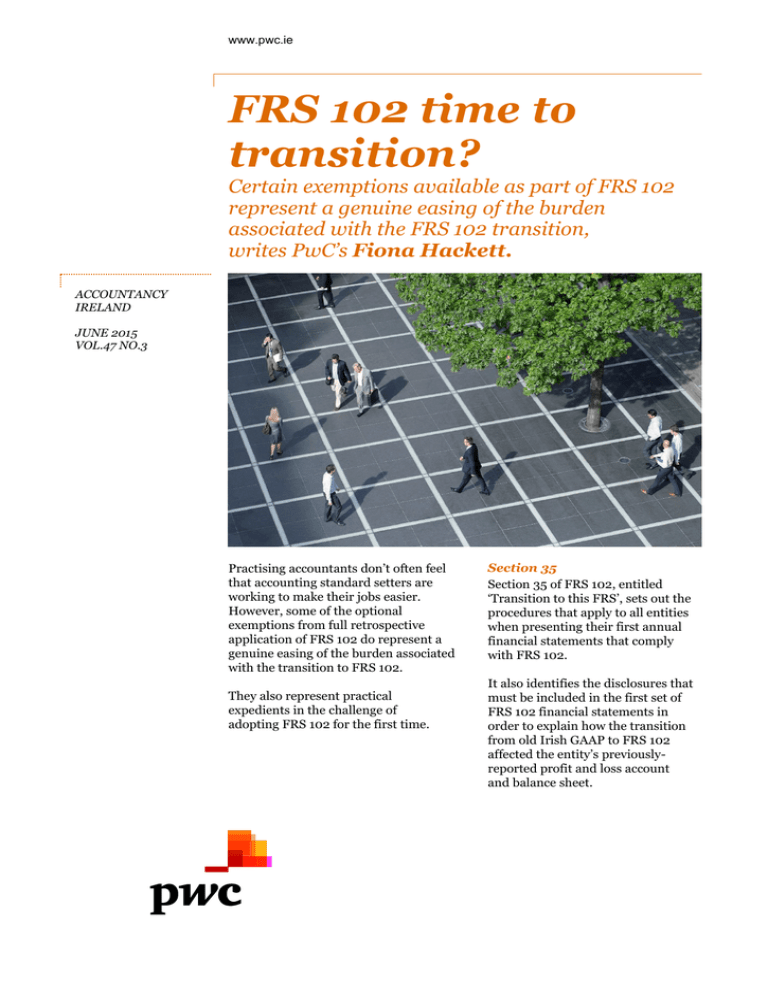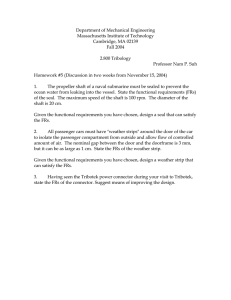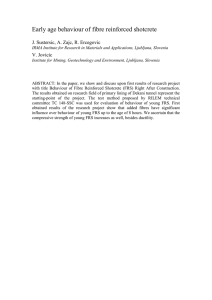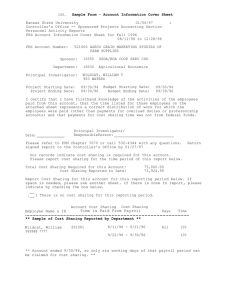
www.pwc.ie
FRS 102 time to
transition?
Certain exemptions available as part of FRS 102
represent a genuine easing of the burden
associated with the FRS 102 transition,
writes PwC’s Fiona Hackett.
ACCOUNTANCY
IRELAND
JUNE 2015
VOL.47 NO.3
Practising accountants don’t often feel
that accounting standard setters are
working to make their jobs easier.
However, some of the optional
exemptions from full retrospective
application of FRS 102 do represent a
genuine easing of the burden associated
with the transition to FRS 102.
They also represent practical
expedients in the challenge of
adopting FRS 102 for the first time.
Section 35
Section 35 of FRS 102, entitled
‘Transition to this FRS’, sets out the
procedures that apply to all entities
when presenting their first annual
financial statements that comply
with FRS 102.
It also identifies the disclosures that
must be included in the first set of
FRS 102 financial statements in
order to explain how the transition
from old Irish GAAP to FRS 102
affected the entity’s previouslyreported profit and loss account
and balance sheet.
Date of transition
FRS 102 requires a first-time
adopter to apply its requirements
to the balance sheet at the date of
transition. The date of transition is
the first day of the earliest
comparative year presented in the
first financial statements prepared
under FRS 102. For a 31 December
year-end the date of transition for
most companies is 1 January 2014.
Optional exemptions
Section 35 of FRS 102 lists a
number of optional exemptions
that an entity may use in preparing
its first FRS 102 financial
statements.
that arise when an entity adopts an
accounting policy of measuring
PPE at valuation. This option can
be applied to individual items of
PPE and, if used, does not have to
be applied to all items of PPE.
Any, all, or none of these options
may be taken. Below are some of
the more attractive options
available.
An entity could therefore cherrypick particular assets to measure at
valuation on transition to FRS 102
and – hopefully – book a one-off
revaluation gain.
General principle
The general principle of FRS 102 is
that the balance sheet at the date of
transition is prepared as though
FRS 102 has always applied i.e.
retrospective application of FRS
102's requirements.
Valuation as deemed cost
Section 35 of FRS 102 contains
exemptions that allow first time
adopters to treat the:
Of course, items of PPE may not be
stated at an amount in excess of
their recoverable amount.
The impact of adopting FRS 102 is
recognised as an adjustment to
retained earnings – or, if
appropriate, another category of
equity – at 1st January 2014.
Section 35 does, however, contain
some mandatory exceptions to the
general principle and some
optional exemptions to make the
transition easier.
Mandatory exceptions
Section 35 of FRS 102 contains
four exceptions to retrospective
application of FRS 102, which must
be applied by all first-time
adopters. The exceptions are:
Accounting estimates made in
previous financial statements
are not revisited. However, any
material errors identified in
previous financial statements
are corrected;
Discontinued operations in the
prior year are not revisited;
Non-controlling interests
(minority interests) are not remeasured; and
Financial assets and financial
liabilities that have been
derecognised are not reinstated.
PwC
Fair value of certain assets as
their deemed cost; and/or
Latest revaluation of certain
assets as their deemed cost.
Fair value as deemed cost
On transition to FRS 102, entities
have the one-time option of
measuring and recognising
property, plant and equipment
(PPE) at fair value at the date of
transition. That fair value then
becomes the asset’s deemed cost,
which in subsequent financial years
is depreciated, re-measured at fair
value, or impaired.
This is essentially a one-time free
pass to use a valuation basis for
PPE, which doesn’t lock the entity
into the ongoing expense and
volatility of regular PPE valuations
Revaluation as deemed cost
Section 35 permits an entity which,
under old Irish GAAP, revalued its
PPE to use the most recent PPE
valuation as the deemed cost of those
assets on transition to FRS 102.
The revalued amount – adjusted if
necessary for depreciation between
the valuation date and the date of
transition to FRS 102 – becomes
the deemed cost of those assets at
the date of transition and is then
depreciated over the remaining
useful economic lives of the assets.
This option essentially represents
an opportunity for entities to move
away from an accounting policy of
measuring their PPE at valuation
and to adopt a simpler cost model
of accounting for PPE under
FRS 102 going forward.
"It is common for Irish entities to
use derivatives, such as forward
foreign currency contracts, to
hedge exposure to foreign currency
fluctuations as part of a financial
risk management programme."
Page 2
Hedge accounting
The most significant impact of
adopting FRS 102 for a number of
Irish entities will be the mandatory
recognition of the fair value of
derivative financial instruments on
their balance sheets.
As a small open economy with
important trading links to the UK and
USA, many Irish entities are exposed
to foreign currency risk arising from
their sales and purchases.
It is therefore common for Irish
entities to use derivatives, such as
forward foreign currency contracts,
to hedge their exposure to foreign
currency fluctuations as part of a
financial risk management
programme.
Section 12 of FRS 102, entitled
‘Other Financial Instruments
Issues’, addresses accounting for
derivatives such as forward foreign
currency contracts.
The general principle of Section 12 is
that derivatives are recognised at fair
value with changes in fair value
recognised in Profit & Loss (P&L),
leading to P&L volatility. Section 12
does allow the use of cash flow hedge
accounting, however, which reduces
P&L volatility by matching the period
in which any gain or loss on the
derivative is recognised in P&L with
the period in which the hedged gain
or loss is recognised in P&L.
Applying cash flow hedge
accounting means that, when a
derivative satisfies the conditions
of a designated hedging relationship and the hedge is considered
effective, any fair value gain or loss
on the derivative is recognised in
other comprehensive income –
similar to the STRGL under old
Irish GAAP – and accumulated in a
cash flow hedging reserve in equity.
When the hedged transaction
occurs, such as a forecast US Dollar
sale, the gain or loss on the
derivative that has been
accumulated in the cash flow hedge
reserve is reclassified from that
reserve to P&L.
PwC
Cash flow hedge accounting for fair
value gains and losses on
derivatives can only begin from the
date when a derivative qualifies as
part of a designated hedging
relationship.
A designated hedging relationship
requires specific documentation
and:
a. Consists of a hedging item, such
as a forward foreign currency
contract to sell US dollar and
buy euro, and a hedged item,
such as a highly probable
forecast US dollar sale and cash
inflow;
b. Is consistent with the entity’s
risk management objective for
undertaking hedges;
c. Has an economic relationship
between the hedged item and
hedging instrument. For
example, a contract to sell US
dollar and forecast US dollar
sale and cash inflow;
d. Is documented with the risk
being hedged (e.g. foreign
currency risk), the hedged item
(highly probable forecast US
dollar sale and cash inflow), and
the hedging instrument (e.g.
forward foreign currency
contract) clearly identified; and
e. Causes of hedge ineffectiveness
determined and documented.
For example, a difference
between the maturity of the
forward foreign currency
contract and the expected date
of receipt of the US dollar cash.
are met no later than the date the
first FRS 102 financial statements
are authorised for issue.
Section 35's exemption in relation
to hedge accounting
documentation is a welcome relief
for first-time adopters of FRS 102
who wish to use cash flow hedge
accounting in their first FRS 102
financial statements.
Business combinations
Accounting for business
combinations is an area of
difference between old Irish GAAP
and FRS 102.
Acquisitive entities adopting
FRS 102 for the first time will be
relieved that they can elect not to
apply Section 19 entitled ‘Business
Combinations & Goodwill’ to
business combinations effected
before the date of transition to
FRS 102.
The practical benefit of this
exemption is that first-time
adopters do not have to carry out
an exercise to separately identify
and value intangible assets, such as
customer lists, acquired in business
combinations completed prior to
the date of transition.
Such intangible assets are likely to
have been subsumed in the
goodwill recognised on acquisitions
under old Irish GAAP.
Entities transitioning to FRS 102 in
2015 that would like to apply cash
flow hedge accounting to
derivatives that existed at the date
of transition, or have been entered
into since, may not have
documented a designated cash flow
hedging relationship for those
derivatives.
The FRS 102 exemption allows the
entity to retain the carrying value
of old Irish GAAP goodwill on
transition to FRS 102. Availing of
this exemption could provide a cost
saving for acquisitive entities
transitioning to FRS 102, as
external professional advice is
often needed to determine the
values of intangible assets acquired
in a business combination.
However, Section 35 offers relief
from the documentation
requirements when applying FRS
102 for the first time by allowing
entities to apply cash flow hedge
accounting if conditions A, B and C
above exist and conditions D and E
It also simplifies the subsequent
accounting under FRS 102, as no
adjustment is made to the carrying
amount of goodwill at the date of
transition and this goodwill
balance is amortised over its
remaining useful life.
Page 3
Deferred development
expenditure
FRS 102 provides an accounting
policy option to recognise an
intangible asset from the
development phase of a project –
once the recognition criteria are
satisfied – or to recognise costs
incurred on development activities
as an immediate expense in P&L.
Entities that previously adopted a
policy of capitalising development
expenditure (under SSAP 13) could
opt to change that policy on
adoption of FRS 102 and begin
recognising costs incurred on
development activities as an
immediate expense, and vice versa.
Borrowing costs
As with deferred development
expenditure, FRS 102 provides an
accounting policy option to
capitalise borrowing costs that are
directly attributable to the
acquisition, construction, or
production of a qualifying asset as
part of the cost of that asset, or to
recognise all borrowing costs as an
immediate expense in P&L.
Entities can opt to change that
policy on adoption of FRS 102. For
example, entities that previously
expensed such borrowing costs can
adopt a policy of capitalising them.
FRS 102 also allows entities the
option to commence capitalisation
of borrowing costs from the date of
transition to FRS 102.
However, where the entity is a
small company – as set out in
Company Law – an increase in
asset values might result in the
company no longer being
considered a small company and
thereby unable to avail of the reliefs
available to small companies in
Company Law.
Opt in or out?
The attractiveness for each entity,
or otherwise, of each optional
exemption needs to be carefully
considered.
In this case, the cost of availing of
the exemption while losing
Company Law reliefs available to
small companies might outweigh
the benefit of an improved balance
sheet that arises from the
exemption.
The costs and benefits may not be
immediately apparent. For
example, on the surface the
‘Valuation as Deemed Cost’
exemptions seem like a quick and
easy win for entities looking to
bolster their balance sheets by
increasing their asset base.
An increased asset base may
enhance an entity’s chances of
obtaining financing, as it
demonstrates the value of potential
security to a bank.
In summary, careful consideration
of the options available in Section
35 is a key element of the transition
to FRS 102.
Fiona Hackett ACA
is a Senior Manager
at PwC.
This content is for general information purposes only, and should not be used as a substitute for consultation with professional advisors.
© 2016 PricewaterhouseCoopers. All rights reserved. PwC refers to the PwC network and/or one or more of its member firms, each of which is a
separate legal entity. Please see www.pwc.com/structure for further details.



